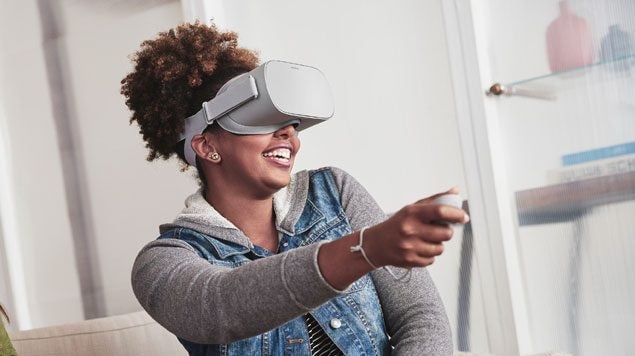There’s now an Oculus VR headset that doesn’t need to be tethered to an expensive computer
At the Oculus Connect developer conference Oct. 11, the Facebook subsidiary unveiled its latest VR headset, the Oculus Go. Unlike the company’s first headset, the Rift, the new Go doesn’t need to be connected to a powerful gaming computer to work, nor does it have any wires for you to get tangled in as you use it.


At the Oculus Connect developer conference Oct. 11, the Facebook subsidiary unveiled its latest VR headset, the Oculus Go. Unlike the company’s first headset, the Rift, the new Go doesn’t need to be connected to a powerful gaming computer to work, nor does it have any wires for you to get tangled in as you use it.
The new headset is Oculus’s first standalone product, and it’ll cost $199. It’s a burgeoning market right now: Last year, just about every VR headset required a connection to a powerful computer, or used a smartphone for its processing power. But neither of these were particularly great experiences—you were either left tethered to a computer by a few feet of cabling, or engaging with very simplistic VR smartphone apps.
Within the last few months, a range of companies have committed to releasing standalone devices, including HTC and Lenovo, with Google’s support, HP, Dell and Acer, with Microsoft’s support; and Samsung, which is launching a $500 standalone “mixed reality” (think virtual objects interacting with the real world) headset in November.
Details on how much better an experience the Go would be over a smartphone-powered headset were unclear, but Oculus lead Hugo Barra said onstage that it was “hands-down the easiest way to get into VR.” It’ll have a sharp HD screen behind a set of specially designed lenses, as well as spatial audio built into the device that moves around as you do in VR. No details were offered on its expected battery life.
Developers will be able to get their hands on the device in November, and it’s expected that consumers will be able to pick one up in 2018.
But the Go is really just a stepping stone to what Oculus has hinted at before: Project Santa Cruz. This is the company’s attempt to build a VR headset that’s as powerful and immersive as the Rift, but without the burdensome wires.
Oculus offered an update on the project’s progress, which seems to look quite polished for something that’s still being prototyped. The company reportedly plans to get this device in the hands of developers next year, but didn’t give any indication on price, battery life, or what exactly you’ll be able to do with it.